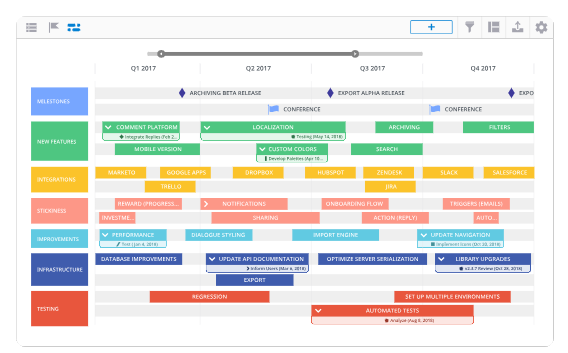The Beginner's Guide to Product Roadmaps
Laying the foundation for mastering product roadmaps not silos.
👋🏻 Hey there, welcome to the #10th edition of the Product Space Newsletter, where we help you become better at product management.
Break into PM from any background. Registrations are open! Enroll now
One of the core responsibilities of a product manager is to define and communicate the strategic direction for their product. This is where product roadmaps come into play.
What is a Product Roadmap?
A product roadmap is like a GPS for your product’s journey. It’s a visual plan that outlines the vision, strategy, and direction of a product over time. It communicates the ‘what’ and ‘why’ behind the features and initiatives you plan to deliver.
A roadmap is not just a list of features or a project plan; it's a strategic tool that helps you align your team, prioritize your efforts, and stay focused on your long-term goals.
Types of Product Roadmaps
There are different types of product roadmaps, each serving a specific purpose:
Strategic Roadmap: Outlines the overarching product vision, key themes, and high-level initiatives for the next 12-24 months.
Release Roadmap: Provides a more detailed view of the features and enhancements planned for upcoming releases, typically spanning 3-6 months.
Feature Roadmap: Focuses on a specific feature or area of the product, detailing the sub-features, dependencies, and timelines.
Why are Product Roadmaps Needed?
Product roadmaps are crucial for several reasons:
Aligning stakeholders and teams: A well-communicated roadmap ensures that everyone is working towards the same goals and understands the rationale behind the product's direction.
Providing a clear vision and direction: By outlining the product's vision and strategy, a roadmap helps you stay focused and makes it easier to prioritize initiatives and allocate resources effectively.
Helping prioritize features and initiatives: A roadmap forces you to prioritize features based on their impact, business value, and feasibility, ensuring that you focus on the most important initiatives first.
Facilitating communication and collaboration: A roadmap serves as a communication tool, enabling cross-functional collaboration and fostering transparency with stakeholders, customers, and partners.
Key Components of a Product Roadmap
A product roadmap typically includes:
Product vision: The overarching goal or purpose of your product
Key themes or initiatives: The major areas of focus for your product over time
Timeframes: When you plan to deliver each theme or initiative, such as quarters or releases
Milestones: Key deliverables or checkpoints along the way
Dependencies: Factors that could impact your roadmaps, such as engineering constraints or market conditions
How to Create a Product Roadmap?
Here are the key steps to create a product roadmap:
Define your product vision and strategy. What is the overarching goal of your product? What are the key themes or initiatives must you focus on to achieve that vision?
Gather input from stakeholders. Talk to your team, customers, sales, support, and other stakeholders to understand their needs and priorities. Conduct user research, surveys, and analytics to identify pain points, opportunities, and potential features.
Prioritize initiatives based on value and feasibility. Rank your initiatives based on how much value they deliver to customers and how feasible they are to build. Focus on the high-value, high-feasibility initiatives first.
Determine timeframes and milestones. Decide how you want to break up your roadmap, such as by quarter or release. Identify key milestones along the way.
Visualize your roadmap. Use a simple tool to visually represent your roadmap. Keep it high-level and focused on the big picture. Select a roadmap format that best suits your needs and audience. Common formats include:
Gantt Charts - Ideal for visualizing project timelines and dependencies.
Kanban Boards - Useful for tracking the progress of individual initiatives or features.
Timeline Roadmaps - Provide a high-level overview of major initiatives and their expected delivery timelines.
Feature-based Roadmaps - Focus on specific features or areas of the product, detailing sub-features and dependencies.
Share and socialize your roadmap. Share your roadmap with your team, stakeholders, and executives. Get buy-in and feedback. Socialize it regularly to keep everyone aligned.
Iterate and update your roadmap. Your roadmap should evolve over time as you learn more about your customers and market. Regularly review and update it based on new information and feedback.
Get the template for your first roadmap
Best practices for working on Product Roadmaps
Focus on outcomes, not outputs: Prioritize solving user problems over building specific features. Great roadmaps are outcome-oriented.
Embrace flexibility: The roadmap is a living document. New data and learnings may require adjustments.
Communication is key: Keep stakeholders informed about progress and potential changes. Manage expectations to avoid surprises.
Learn from the best: Don't reinvent the wheel. Explore resources and best practices from experienced product managers.
Key Takeaway:
Product roadmaps are powerful tools for guiding your product's success. This edition has equipped you with the basics, but the journey continues!
As you gain experience, explore advanced roadmap concepts like roadmaps for different product stages (launch, growth, maturity). But, the key is to be user-focused, adaptable, and a good communicator.
That’s a wrap for today!
Got a product story or a handy tips to share about Product Roadmaps? We’d love to hear from you!
Share in the comments below or reply to this email.
Until next time, keep innovating, keep iterating, and above all, keep being awesome.
Cheers!
Product Space





